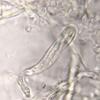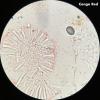
08-12-2025 18:59
 Lothar Krieglsteiner
Lothar Krieglsteiner
.. found by a seminar-participant, I do not know t

08-12-2025 17:37
 Lothar Krieglsteiner
Lothar Krieglsteiner
20.6.25, on branch of Abies infected and thickened

07-12-2025 16:07
Arnold BüschlenHallo, ich habe in einer Moos-Aufsammlung (epiohy

16-03-2014 22:00
Hello,I found this species a few months ago but ha

08-12-2025 13:39
Thomas Læssøehttps://svampe.databasen.org/observations/10572899

05-12-2025 17:33
 Bruno Coué
Bruno Coué
Bonjour, je serais heureux de recueillir votre avi

06-12-2025 00:19
 Viktorie Halasu
Viktorie Halasu
Hello, would anyone have this article, please? An
Orbilia...
Ethan Crenson,
22-10-2025 06:43
Hi all,
I'm having some difficulty with this Orbilia. The apothecia are orange and on hardwood which was on the ground. Margin is smooth.
Asci 25-33 x 4-5µm
Spores are elongated, fusoid, mostly straight but infrequently curved.
8.0-13.2 x 1.2-1.6µm
Me: 10.4 x 1.4µm.
Me: 10.4 x 1.4µm.
Spore bodies sometimes a short line, sometimes longer, occasionally with an enlargement at the end. Spore body length 1.4-2.9µm
Paraphyses clavate, almost capitate at the ends and coated with exudate (which I found stains pink in Congo red.)
I would be very grateful for any assitance.
Ethan
Hans-Otto Baral,
22-10-2025 11:33

Re : Orbilia...
Hi Ethan
Although on the ground this is a member of subgenus Hemiorbilia, which are al drought-tolerant.
It must belong in the complex of O. vinosa. From typical O. vinosa it differs in too small, especially narrow spores. There is still much to explore, but these potentially different taxa can hardly be identified without DNA. Surely a sequence would be clarifying in this case, if you have enough apothecia.
Zotto
Ethan Crenson,
22-10-2025 17:26
Re : Orbilia...
Thank you! I had a moment when I thought it might be O. vinosa. I will attempt to sequence this and I will share it with you if I am successful.
E







